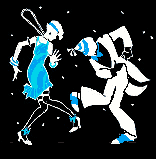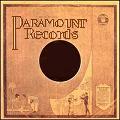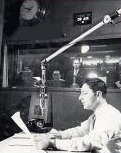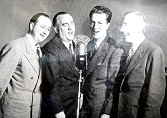|
more 1920s topics Nostalgia Cafe main page Nostalgia Cafe site map | 1920s Music & Entertainment============================================================ ============================================================ ============================================================ | ||
 1920s Hit Songs
1920s Hit Songs
|
1920 I'll Be With You In Apple Blossom Time (Charles Harrison/Albert Campbell & Henry Burr) Tell Me Little Gypsy (Art Hickman's Orchestra) When My Baby Smiles At Me (Ted Lewis & His Orchestra) Alice Blue Gown (Edith Day) Left All Alone Again Blues (Marion Harris) Mah Lindy Lou The Japanese Sandman (Nora Bayes/Paul Whiteman & His Orchestra) Wild Rose The Moon Shines On The Moonshine (Bert Williams) Prohibition Blues (Nora Bayes) Whispering (Paul Whiteman & His Orchestra) Rose Of Washington Square (Johnny Hamp's Kentucky Serenaders) Dardanella (Selvin's Novelty Orchestra) You'd Be Surprised (Eddie Cantor) | ----- | 1921 They Wanted A Songbird In Heaven (So God Took Caruso Away) There'll Be Some Changes Made Second Hand Rose (Fanny Brice) Ma, He's Makin' Eyes At Me My Man (Fanny Brice) Ain't We Got Fun (Van & Schenck) Baby Face I'm Just Wild About Harry Crazy Blues (Mamie Smith & Her Jazz Hounds) The Sheik Of Araby My Mammy (Paul Whiteman & His Orchestra/Peerless Quartet) Wabash Blues Look For The Silver Lining (from "Sally") Margie | ||
| 1922 Stumbling Chicago (That Toddlin' Town) Toot Toot Tootsie, Goo'bye (Al Jolson) Carolina In The Morning I Wish I Could Shimmy Like My Sister Kate (Jazzbo's Carolina Serenaders) | 1923 Yes! We Have No Bananas Who's Sorry Now? Downhearted Blues (Bessie Smith) That Old Gang Of Mine I Love Life | |||
| 1924 Rhapsody In Blue (Paul Whiteman & His Orchestra) Indian Love Call (from "Rose Marie") Deep In My Heart, Dear (from "The Student Prince") Serenade (from "The Student Prince") It Had To Be You Lady Be Good Hard-Hearted Hannah (The Vamp Of Savannah) What'll I Do? The Prisoner's Song (Vernon Dalhart) Wild Women Don't Have The Blues (Ida Cox) Does The Spearmint Lose Its Flavor On The Bedpost Overnight? (Billy Jones) California Here I Come (Al Jolson) The Man I Love Tea For Two |
1925 I'm Sitting On Top Of The World (Al Jolson) If You Knew Susie, Like I Know Susie Manhattan Yes Sir, That's My Baby (Coon-Sanders Nighthawks Orchestra) Sweet Georgia Brown Alabamy Bound (Paul Whiteman & His Orchestra) Show Me The Way To Go Home (The California Ramblers) Always Charleston (Paul Whiteman & His Orchestra) Collegiate (Fred Waring & His Pennsylvanians) My Bundle Of Love (Gene Austin) Don't Bring Lulu Old Dan Tucker (Uncle Dave Macon) | |||
| 1926 Bye Bye Blackbird Black Bottom (Johnny Hamp's Kentucky Serenaders) April Showers (Al Jolson) A Cup Of Coffee, A Sandwich, And You (Gertrude Lawrence) Poor Little Rich Girl (Gertrude Lawrence) The Birth Of The Blues The Sugar Foot Stomp | 1927 I'm Looking Over A Four-Leaf Clover Chlo-e Me And My Shadow Make Believe (from "Showboat") Ol' Man River (from "Showboat") Varsity Drag (George Olsen & His Music w/Fran Frey) My Blue Heaven (Gene Austin) Do-Do-Do (Gertrude Lawrence) Someone To Watch Over Me (Gertrude Lawrence) Back Water Blues (Bessie Smith) My Mammy (Al Jolson) Blue Skies (Belle Baker/Al Jolson) Black & Tan Fantasy (Duke Ellington) Ain't She Sweet (Gene Austin) Hallelujah! My Heart Stood Still Strike Up The Band 'S Wonderful Thou Swell | |||
| 1928 I Want To Be Loved By You (Helen Kane) Let's Misbehave (Irving Aaronson & His Commanders) Little Orphan Annie (Coon-Sanders Nighthawks Orchestra) Mack The Knife Makin' Whoopee (Eddie Cantor) Button Up Your Overcoat You're The Cream In My Coffee I Ain't Got Nobody East St. Louis Toodle-oo (Duke Ellington) Sonny Boy (Al Jolson) Ramona (Gene Austin) Let's Do It (Let's Fall In Love) Lover, Come Back To Me Henry's Made A Lady Out Of Lizzie | 1929 Louise (Maurice Chevalier) If I Had A Talking Picture Of You (Johnny Hamp's Kentucky Serenaders) Nobody Knows You When You're Down And Out (Bessie Smith) West End Blues (Louis Armstrong) (What Did I Do To Be So) Black And Blue? (Louis Armstrong) St. Louis Blues (Louis Armstrong w/Bessie Smith) Am I Blue Stardust Tip Toe Through The Tulips | |||
===========================================================================
===========================================================================
===========================================================================
===========================================================================
 Music Styles Music Stylesjazz Jazz had its beginnings in New Orleans in the 1890s. By the 1910s, it was popular throughout the South, and many jazz musicians were making quite a name for themselves. After World War I, the Great Migration brought thousands of black people to northern cities, and jazz found a new home in places like Chicago, Detroit and New York City. King Oliver, Fletcher Henderson and Louis Armstrong all came north during this time. blues Jazz was born in the city. The blues, on the other hand, came straight from the souls of down-home country folk. This musical style was based on the field hollers, slave chants and spirituals of the 1800s. Black composer and bandleader W.C. Handy first heard it in 1903, and with his support it became a popular music style among black people. showtunes Many Broadway shows featured songs that became popular in both record and sheet music format. Rose Marie, Showboat, The Student Prince and the Ziegfeld Follies all contributed songs to our national culture. Fanny Brice, Gertrude Lawrence, Helen Kane, Al Jolson and Eddie Cantor were some of the performers who had great success with their stage hits. hillbilly music In the late 1920s, fiddle and banjo music gained a wider audience when the first country music recordings were made. In 1927, record producer Ralph Peer took his equipment to Bristol, Tennessee and made a series of recordings featuring local country and bluegrass musicians. These recording sessions launched the careers of artists like Jimmie Rodgers, Ernest Tubb and the Carter Family. novelty songs The exuberant, fun-loving mood of the 1920s was captured perfectly in songs like "Yes! We Have No Bananas" and "Does The Spearmint Lose Its Flavor On The Bedpost Overnight?" | ----- |
the "new music" wasn't enjoyed by everyone.... DOES JAZZ PUT THE SIN IN SYNCOPATION? "Jazz originally was the accompaniment of the voodoo dancer, stimulating the half-crazed barbarian to the vilest deeds. The weird chant, accompanied by the syncopated rhythm of the voodoo invokers, has also been employed by other barbaric people to stimulate brutality and sensuality." --Anne Shaw Faulkner, Ladies' Home Journal, 1921 (read the complete article here) The 1927 Bristol Sessions Jazz Standards Jazz & Blues Sound Clips  Dancing In the 1920s, popular dances included the Tango, Fox Trot, One-Step, Waltz and Black Bottom. In 1926, young people at the Savoy Ballroom invented an energetic dance they called the Lindy-Hop. When an observer inquired about the name of the hot new dance, one of the dancers glanced at a newspaper with the headline "Lindy Hops Across Atlantic" and thought it would make a good name. The hottest dance in the 1920s was the Charleston. This wild, free-spirited dance came from the 1924 all-black Broadway show Runnin' Wild. It took the country by storm, although at first it was considered immoral and was banned in many places. The Shimmy was another scandalous dance in the 1920s. Usually, anyone caught attempting this dance was removed from the dance floor and tossed out on his ear! | ||
===========================================================================
===========================================================================
===========================================================================
===========================================================================
The Recording Industry
 acoustic recording Before 1925, all recording was done acoustically: the artist performed into a recording horn, and the sound waves imbedded a groove in the wax master disc. The process was adequate for recording brass instruments, but lacked the sensitivity needed to produce high quality symphony and vocal recordings.  electrical recording Electronic recording was introduced in 1925. Now, instead of screaming into a recording horn, the artist performed into a microphone, and the recording was created by electrical wiring and amplifiers. This resulted in greater sound quality and amplification, and made it possible to successfully record vocalists, orchestras and large groups. 33 1/3 RPM: the professional speed In the 1920s, the average record was 10 or 12 inches wide, played at 78 RPM and contained approximately four minutes of music per side. When movies first began to "talk" in the mid 1920s, it became necessary to find a longer recording format that could be synchronized with an 11-minute reel of film. The records were enlarged to 16 inches and a slower recording speed of 33 1/3 RPM was adopted. Soon, radio stations and record companies were using this professional speed for their transcriptions and wax master discs. | ----- | record labels By the early 1920s, most record companies had abandoned the cylinder format in favor of flat discs. Edison was the last manufacturer to issue cylinder recordings. His blue amberols were available until 1929, and could only be obtained directly from the factory. Usually, each record label specialized in a specific type of music. The larger companies issued several labels. Take Victor, for example....standard popular tunes were released on Victor's regular label, opera and symphony records were released as Victor Red Seal records, and African-American blues music was released on their Victor Race Records label.  Okeh
OkehBrunswick Odeon Parlophone Columbia Victor Pathe Emerson Perfect 
Paramount Gennett Victor Red Seal Edison Diamond Discs Black Swan Regal Vocalion  race records
race recordsRace records were made for black audiences and featured black artists performing what was known as race music....jazz and blues. The artists who made them became known as race artists. The Okeh label was the first to create a race record division in 1920. Soon, most of the other major record companies were forming separate race record divisions, including Victor, Columbia, Paramount and Brunswick. | ||
===========================================================================
===========================================================================
===========================================================================
===========================================================================
The Radio Industry
|
before the 1920s The first human voice was transmitted by radio waves in 1900. During the 1900s and 1910s, experimental radio stations were built and listeners tuned in using homemade crystal sets. When America entered World War I, the government suspended all amateur radio licenses. Radio technology was used by the military, both on the battlefield and here in the states. In 1919, the war was over and the wartime ban was lifted. Experimental stations resumed broadcasting. 8XK in Pittsburgh In 1919, Westinghouse engineer Frank Conrad reopened his home-based experimental station 8XK. He went on the air two evenings a week, playing records that were provided by a local music store in exchange for on-the-air plugs. His broadcasts were very popular in the Pittsburgh area.  radio as a business? During 1919 and 1920, the executives at Westinghouse observed two things: more and more people were buying "do-it-yourself" radio kits, and Frank Conrad's broadcasts were becoming increasingly popular. They came up with a brilliant idea....if they provided regular programming, people would need to buy radios....Westinghouse radios. KDKA in Pittsburgh In 1920, Westinghouse constructed a transmitter and shack on the roof of their Pittsburgh factory. Their goal was to be ready in time to broadcast the results of the Harding-Cox presidential election in November. They applied for a license and were given a temporary amateur license (8ZZ) until their commercial license was granted a few days later. They were given the call-letters KDKA.  The KDKA studio the first night KDKA met their deadline and aired their first broadcast on election night in 1920. They reported on the Harding-Cox election from 8 p.m. to midnight. Between updates, they filled the time with phonograph records and a banjo player. | ----- |
amateur vs. commercial Before KDKA went on the air, the commercial licensing category consisted solely of wireless Marconi stations that provided Morse code communication and news. All audio stations were in the "experimental" and "amateur" categories. In 1921, the Department of Commerce added a new category to their licensing criteria: broadcast stations. From now on, all commercial audio stations would fall into this category.  regular programming begins KDKA launched their regular broadcasting schedule the day after their election-night debut. They provided one hour of entertainment and news each evening from 8:30 to 9:30. In 1921, KDKA was joined by nine new commercial broadcast stations. Three of them were located at Westinghouse factories in other cities. The Radio Corporation of America (RCA) was involved primarily with wireless Marconi, but in 1921 they also jumped on the audio bandwagon and launched a commercial station. In 1922, there were 30 stations in existence. By 1923 there were 550 stations, and in 1927 there were 680 stations on the air.  radio firsts 1920: first pre-announced and regularly scheduled broadcasts, first radio prize fight, first radio dance band, first college radio station 1921: first radio religious service, first president to speak on the air (Warren G. Harding) 1922: first program entirely sponsored by one advertiser, first complete symphony broadcast, first Broadway show on the air (The Perfect Fool with Ed Wynn) world's largest store The first commercial radio stations were owned by some very unlikely companies. It seemed like everyone was going into the broadcasting business. Turn the dial in the 1920s and you'd find stations owned by stockyards, department stores, laundries, radio manufacturers, newspapers, universities, pharmacies, creameries and hospitals. Gimbel's in New York City owned a station that operated directly from the store itself. The call-letters of many stations reflected their ownership. Here are some examples from the 1920s: WLS: World's Largest Store (Sears) WBBM: We Broadcast from the Broadmoor ballrooM WCFL: Chicago Federation of Labor WMBB: World's Most Beautiful Ballroom (the Trianon) WGN: World's Greatest Newspaper (Chicago Tribune) KFKB: Kansas Folks Know Best WSM: We Shield Millions (National Life & Accident Insurance Co.) | ||
return to the 1920s main page